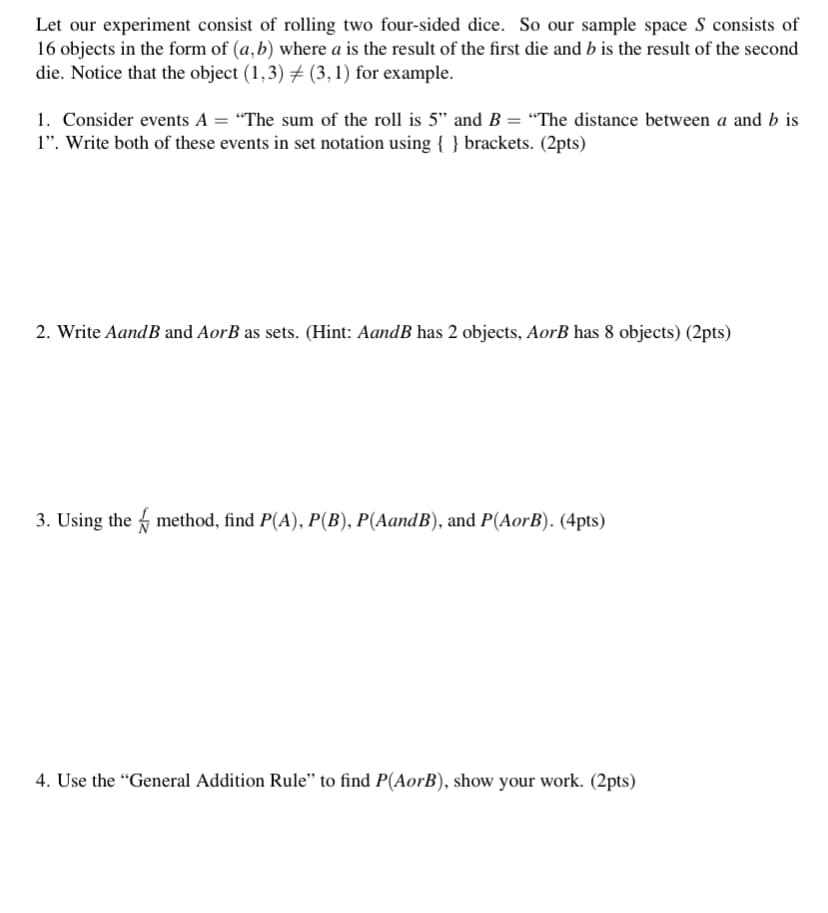Let our experiment consist of rolling two four-sided dice. So our sample space S consists of 16 objects in the form of (a, b) where a is the result of the first die and b is the result of the second die. Notice that the object (1,3) # (3, 1) for example. 1. Consider events A = "The sum of the roll is 5" and B = "The distance between a and b is 1". Write both of these events in set notation using {} brackets. (2pts) 2. Write Aand B and AorB as sets. (Hint: AandB has 2 objects, AorB has 8 objects) (2pts) 3. Using the method, find P(A), P(B), P(AandB), and P(AorB). (4pts)
Let our experiment consist of rolling two four-sided dice. So our sample space S consists of 16 objects in the form of (a, b) where a is the result of the first die and b is the result of the second die. Notice that the object (1,3) # (3, 1) for example. 1. Consider events A = "The sum of the roll is 5" and B = "The distance between a and b is 1". Write both of these events in set notation using {} brackets. (2pts) 2. Write Aand B and AorB as sets. (Hint: AandB has 2 objects, AorB has 8 objects) (2pts) 3. Using the method, find P(A), P(B), P(AandB), and P(AorB). (4pts)
Holt Mcdougal Larson Pre-algebra: Student Edition 2012
1st Edition
ISBN:9780547587776
Author:HOLT MCDOUGAL
Publisher:HOLT MCDOUGAL
Chapter11: Data Analysis And Probability
Section: Chapter Questions
Problem 8CR
Related questions
Question
100%

Transcribed Image Text:Let our experiment consist of rolling two four-sided dice. So our sample space S consists of
16 objects in the form of (a, b) where a is the result of the first die and b is the result of the second
die. Notice that the object (1,3) # (3, 1) for example.
1. Consider events A = "The sum of the roll is 5" and B = "The distance between a and b is
1". Write both of these events in set notation using { } brackets. (2pts)
2. Write AandB and AorB as sets. (Hint: AandB has 2 objects, AorB has 8 objects) (2pts)
3. Using the method, find P(A), P(B), P(AandB), and P(AorB). (4pts)
4. Use the "General Addition Rule" to find P(AorB), show your work. (2pts)
Expert Solution
This question has been solved!
Explore an expertly crafted, step-by-step solution for a thorough understanding of key concepts.
This is a popular solution!
Trending now
This is a popular solution!
Step by step
Solved in 4 steps

Recommended textbooks for you

Holt Mcdougal Larson Pre-algebra: Student Edition…
Algebra
ISBN:
9780547587776
Author:
HOLT MCDOUGAL
Publisher:
HOLT MCDOUGAL

College Algebra
Algebra
ISBN:
9781305115545
Author:
James Stewart, Lothar Redlin, Saleem Watson
Publisher:
Cengage Learning

Holt Mcdougal Larson Pre-algebra: Student Edition…
Algebra
ISBN:
9780547587776
Author:
HOLT MCDOUGAL
Publisher:
HOLT MCDOUGAL

College Algebra
Algebra
ISBN:
9781305115545
Author:
James Stewart, Lothar Redlin, Saleem Watson
Publisher:
Cengage Learning